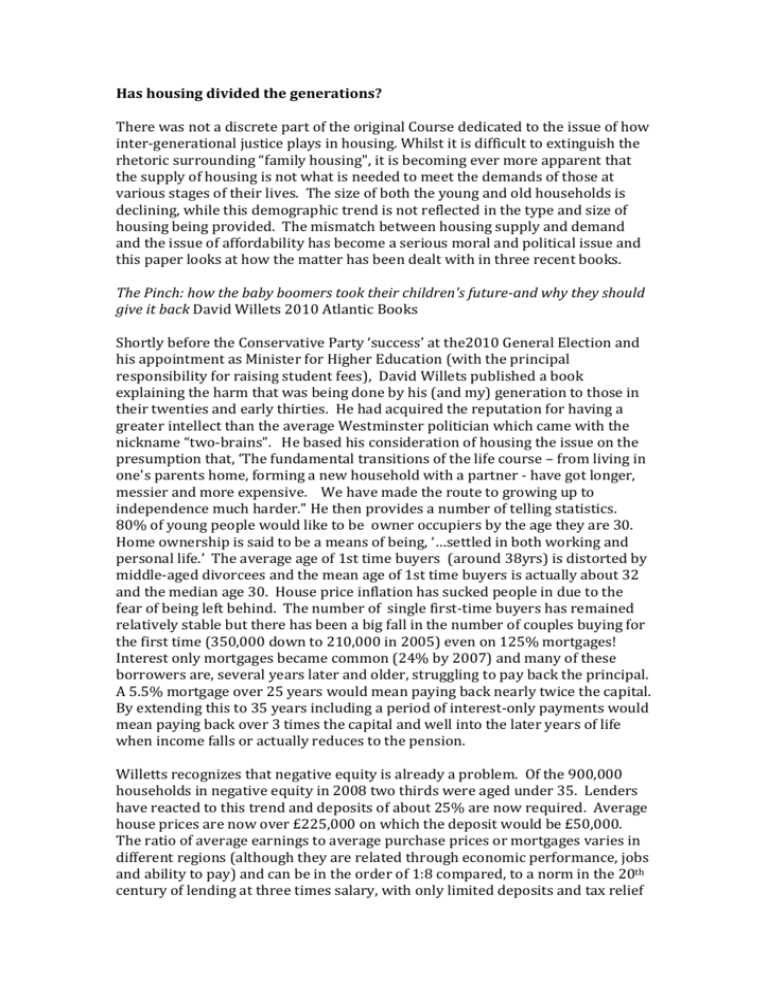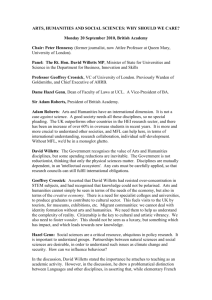Has housing divided the generations?
advertisement

Has housing divided the generations? There was not a discrete part of the original Course dedicated to the issue of how inter-generational justice plays in housing. Whilst it is difficult to extinguish the rhetoric surrounding “family housing", it is becoming ever more apparent that the supply of housing is not what is needed to meet the demands of those at various stages of their lives. The size of both the young and old households is declining, while this demographic trend is not reflected in the type and size of housing being provided. The mismatch between housing supply and demand and the issue of affordability has become a serious moral and political issue and this paper looks at how the matter has been dealt with in three recent books. The Pinch: how the baby boomers took their children's future-and why they should give it back David Willets 2010 Atlantic Books Shortly before the Conservative Party ‘success’ at the2010 General Election and his appointment as Minister for Higher Education (with the principal responsibility for raising student fees), David Willets published a book explaining the harm that was being done by his (and my) generation to those in their twenties and early thirties. He had acquired the reputation for having a greater intellect than the average Westminster politician which came with the nickname “two-brains”. He based his consideration of housing the issue on the presumption that, ‘The fundamental transitions of the life course – from living in one's parents home, forming a new household with a partner - have got longer, messier and more expensive. We have made the route to growing up to independence much harder." He then provides a number of telling statistics. 80% of young people would like to be owner occupiers by the age they are 30. Home ownership is said to be a means of being, ‘…settled in both working and personal life.’ The average age of 1st time buyers (around 38yrs) is distorted by middle-aged divorcees and the mean age of 1st time buyers is actually about 32 and the median age 30. House price inflation has sucked people in due to the fear of being left behind. The number of single first-time buyers has remained relatively stable but there has been a big fall in the number of couples buying for the first time (350,000 down to 210,000 in 2005) even on 125% mortgages! Interest only mortgages became common (24% by 2007) and many of these borrowers are, several years later and older, struggling to pay back the principal. A 5.5% mortgage over 25 years would mean paying back nearly twice the capital. By extending this to 35 years including a period of interest-only payments would mean paying back over 3 times the capital and well into the later years of life when income falls or actually reduces to the pension. Willetts recognizes that negative equity is already a problem. Of the 900,000 households in negative equity in 2008 two thirds were aged under 35. Lenders have reacted to this trend and deposits of about 25% are now required. Average house prices are now over £225,000 on which the deposit would be £50,000. The ratio of average earnings to average purchase prices or mortgages varies in different regions (although they are related through economic performance, jobs and ability to pay) and can be in the order of 1:8 compared, to a norm in the 20th century of lending at three times salary, with only limited deposits and tax relief on the interest. Negative equity is a personal problem but also has a depressing affect on the activity ion the housing market – including the mobility required by those looking for work – as well as the actual level of house prices. A falling market that would be welcomed by those unable to pay the current prices could grind to a halt through lack of building and reluctant sellers. Many young people are now living in desperately cramped conditions. Immigration (and the relatively high fertility rates of migrants) has become a major narrative in the politics of the 21st century. The pressure this is said to place on housing is providing fuel to the BNP and UKIP which impacts on the policies and presentation of the main parties. House prices and rents also drive migration to areas of the country with lower property values and even emigration. What has become spare equity and space is traded in for and cheaper and often smaller accommodation at home or abroad. The loss of housing benefit to those in socially rented accommodation for any bedroom with no permanent occupier (tagged the ‘bedroom tax’) was mentioned in the Introduction. This, and the inability of councils (particularly in London) to find accommodation to meet local needs has led to tenants being ‘offered’ accommodation in distant parts of the country. Tenants looking to downsize in order to avoid the ‘bedroom tax’ have found that suitable smaller units are in short supply and the ‘tax’ could give rise to a dislocation of social tenants – or a move into a less secure private sector. According to Willetts, “The social contract is an important part of Western political thought. I believe it is really a contract between the generations. This intergenerational contract is at the heart of the family and the welfare state. [Contracts]…depend on reciprocity … that sustains cooperative behaviour and gives people a sense of well-being. A central argument in the book is that we are not attaching sufficient value to the claims of future generations. We do not have a clear way of thinking about the rights of future generations.” The book does not anticipate the increase in student fees or the effect of this measure on intergeneration injustice. Now in power, Willetts says (private correspondence with the writer) that the fees hike was inevitable due to the huge increase in student numbers since the days when higher education was free. Although not within his ministerial responsibilities, he sees an increase in housing supply as the effective remedy for the inequity of unaffordable prices. Although the Government (actually a coalition) has not completed its programme, there are no signs of a dramatic increase in housing supply (currently at about 50% of the estimated need of 200,000 units per annum) or that prices are falling, that would have serious economic and political consequences. In fact, taking the systemic view of housing supply, this is closely related to the responsibilities of the higher education minister. What new households are able to pay for their first homes (known as ‘first time buyers’) affects the value of these properties. If it is a new dwelling then the builder’s income is affected as is their willingness and ability to build. If it is secondhand property, then the money available to successive sellers wanting to move along the housing chain will affect prices all the way up the ladder. The debt carried by young people at the end of their formal education will depress the amount they will be able to borrow and, therefore, the price of housing. A recurring theme of the Course is the danger of underestimating the complexities in the housing system and the difficulty in understanding the linkages, feedback loops and rebound effects. However, it seems likely that, below a certain level of prices, builders will be unwilling to build and the fees increase brought in by Willetts could be contributing to further injustices by putting a break on housing supply. Them and Us: changing Britain-why we need a fair society Will Hutton 2010 Little Brown This book was written after the 2010 election. It is intended by Hutton to address the issue of ‘fairness’ in the context of a challenging economic climate. His thesis is based on the premise that unfairness is economically inefficient and that we should be looking for a new form of capitalism that increases levels of fairness. Taking a cue from Willetts and Howker and Malik (see below) on questions of fairness, Hutton would be expected to address housing as one of the most obvious sources of unfairness. However, in 400 pages, so little is actually said that the recommendations can be quoted here in full; “There should be a commitment to end the quasi-apartheid of current social housing. Britain must build no more enormous social housing estates, but rather aim to build communities with many types of tenure - rented, owner occupied and shared ownership. But two more radical reforms would be required too. The first would give all households in whatever tenure a housing cost credit so that low- and middle income groups would have the same universal support. The second would levy a property tax or capital gains tax on profits made from homeownership. Perhaps the least controversial and most politically flexible form of property tax would be stamp duty on house sales as well as on purchases… But whatever means, British residential property can no longer be largely tax-exempt zone. If all this were done, from education to housing, the British would become more socially integrated, more fluid, more socially mobile and more intellectually, culturally and practically predisposed to take risks. We would also become wealthier, more dynamic, fairer and happier society." Hutton sees the current housing stock as oppressive and a representation of inequality in our society. The scale should be reduced, the building types more varied and the tenures more mixed (known as pepper-potting) to avoid the stigma attached to the social rented sector. Whatever the effect a universal housing credit might have, the universal credit being introduced by the coalition Government is more far-reaching, and that associated with housing seems to be a leveling down. If the introduction of capital gains tax on housing or stamp duty on sales would slow down an already depressed housing market, neither would appear to be attractive to this or a subsequent Government. It might take some time for any increase in revenue from either or both these new taxes to compensate for the loss of buyers’ stamp duty in a sluggish market. It is true that money plays a part in significant parts of the housing system making it an attractive means of change and control. However, even relatively independent and sophisticated thinkers such as Hutton can fail to appreciate the systemic effects of apparently simple measures. Them and Us is in the form of a manifesto but Hutton, Chairman of the Work Foundation, is clearly more comfortable with other areas of the economy as there is no mention of housing in the conclusion! That is not to say that at least one part of the Coalition Government has abandoned all intentions of raising revenue from housing. The business secretary Vince Cable has been advocating an increase in the upper Council Tax bands or a Mansion Tax impacting on the value of property in excess of £2m. Something similar would have Labour Party support. A reader of the Daily Telegraph pointed out that such a tax would reduce the value of these expensive properties that would often form part of the estate when the owners died. Such loss of value in estate duties could exceed the increase in the income from the mansion tax itself. Although the Conservative part of the coalition, probably with more supporters living in this type of property, are not in favour of such a tax, rebound effects have not been given as a reason. Jilted generation: how Britain has bankrupted its youth Howker E and Malik S 2010 Icon Books Written by two twenty- somethings as they approached the age of 30, the book deals with intergenerational injustice under 4 interelated headings; housing, jobs, inheritance and politics. As implied in the title, it is a polemic that does not simply describe the plight of younger people but apportions blame. The jilting, according to the authors, is largely if inadvertently, being carried out by their elders. The analysis bears comparison with that of Guy Browning in his 2011 book The Precariat: the new dangerous class and shares with Willetts a call to action. All three, adopt a position that the predicament of the young can only be resolved through the cooperation if not a renewed contract with older generations. Jilted is a rich source of data in respect of housing in Britain. It builds up a picture of growing despair where all the trends in housing seem to be going in the wrong direction. This is summed up by the increasing age of the average first-time buyer although this is distorted by much older buyers from broken relationships. The book stresses the importance of adequate housing to the wider society and its relationship with employment and the starting and bringing up families. Whilst the extent of the current dilemma is being described, the fundamental claim is that those with power, including all property owners, are lacking the necessary vision to tackle the collective problem. This is attributed to a failure to properly examine the future, a future that might arrive when it is least expected. ‘Buy to let' investors seem to have made a bad situation worse. Although the average age of a buy-to-let investor has gone up, it is only 48 years. This suggests that there are many members of younger generations who have jumped the divide and secured a place (all places) on the property ladder. However, there are very many such investors reaching retirement where Britain's young people will be paying their old age pensions through employment taxes as well as rents, whilst re-paying tuition fees. For this group of young people home ownership, particularly in areas of low unemployment and high property prices, is a distant dream. Not only are just 13% of the under 35s in owner-occupation (this would be about 20% were there a fair distribution across the generations) but very few social tenants are under the age of 35. This is seen as an indictment of society’s lack of ability or willingness to increase the supply of social housing having sold off so much of the stock during and after the Thatcher era to the benefit of that generation of social renters. The result is that the under 35s are disproportionately housed in the private rental sector. This is only lightly regulated. Rents follow the market and security is usually no more than 6 months or a year. Although the social rented sector is raising the standards in terms of energy efficiency as one important response to fuel poverty, the private sector, even with incentives (an energy performance certificate is required prior to any new tenancy), is lagging behind. In order to pay the rent, many of those in the private rental sector occupy shared and often cramped accommodation. The Joseph Rowntree Foundation believe that every year there are 60,000 new households entering the ‘trap’ created by being too rich to qualify for council/social housing and too poor to afford a mortgage (or, crucially, a deposit). Howker and Malik put the number of households in this trap at more than 1.2 million. Many consequences are attributed to lack of adequate housing, including violence among young adult men having to delay their move to some social independence from their families. Shelter has found (report Full House?) that overcrowding has negative effects on family relationships, arising from lack of privacy, depression/stress, lack of room to play leading to arguments, fighting and sleep disturbance. Perhaps the most disturbing aspect of the housing crisis being faced by younger people is the effect on both marriage rates and the starting of families. These behaviours are attributed to lack of stability and lack of space and money. It is important to add to that lack of money can also apply to those who have stretched their individual or joint incomes in order to buy a house. Given that many of these deprivations are mirrored by privileges being enjoyed by older generations the logical response would be a more equitable distribution of resources. However, housing has many dimensions that would need to be disentangled before the access to space could be redistributed. Postscript 2013 The Coalition Government is acutely aware of the potency of housing as a vote winner or loser. The Chancellor has introduced a number of incentives designed to increase the ability of housebuyers to meet existing property prices. In fact, many commentators on the 2013 Budget suggested that the 20% homebuyer loan guaranteed by the Government could serve to increase house prices. The consequences of a falling market (eg negative equity, lack of consumer confidence) are seen by Government as so severe that subsidies on the demand side continue. Priced out (http://www.pricedout.org.uk/) is an organisation campaigning for policies that would make houses more affordable for everybody and not just those eligible for Government ‘bungs’. Another 2013 Government initiative is the proposal to increase the scale by which houses can be extended without obtaining planning permission in order to provide work for small building companies and as a spur to the local economy. The opposition to this proposal has come mainly from those (including MPs) concerned that larger house extensions could affect the amenity and value of neighbouring property. However, the main effect of such a change would be to enable owner occupiers to increase both the size and the value of their properties thereby moving the housing ladder away from those who have not yet grasped its lowest rung. Levels of under-occupancy are already highest in the owner occupancy sector as older generations both enjoy and extend the most reliable element of their ‘pensions’. There are 26 million homes requiring substantial work to bring them up to a standard of energy efficiency required by the Climate Change Act 2008 (at least an 80% increase in energy efficiency). It could be argued that greater priority should be given to this work than to the use of raw materials to create greater and possibly unneeded and unused space all of which might require energy for heating. Although currently the subject of a High Court challenge, the Communities Secretary has sought to remove a requirement to upgrade the efficiency of existing dwellings as part of any building project (e.g a house extension).requiring building regulations approval. These are just two examples of the difficulty experienced in accurately diagnosing the problems of matching housing supply with the demand for attractive, warm and stable homes. Exercise Looking at ‘housing’ as a system, start to build a rich picture or systems diagram that includes its main elements and sub-systems. Such a diagram can start to reveal the complexity of the housing system but also become an aid to making interventions which are more likely to have net beneficial effects. DRS 2013 04 16










